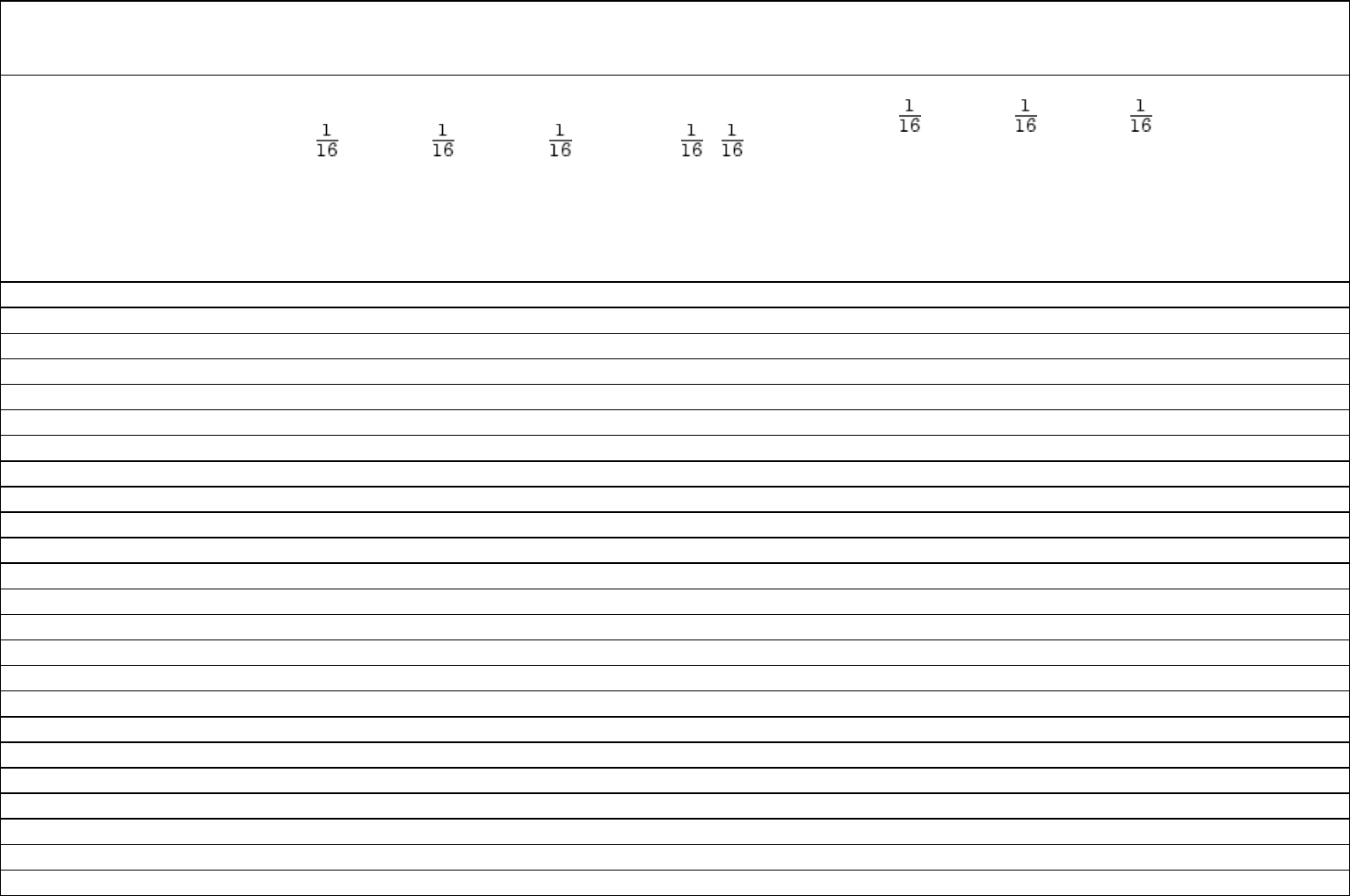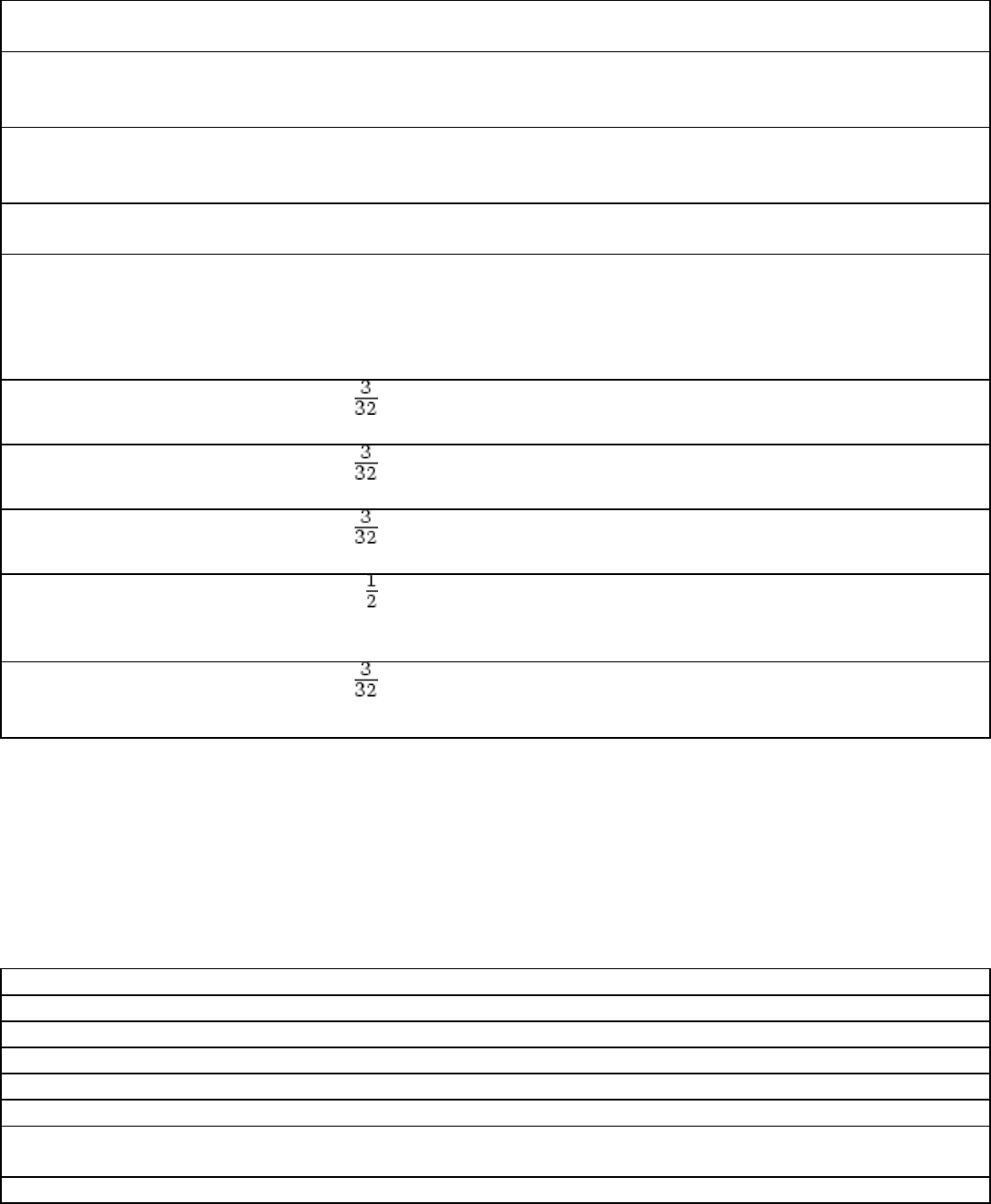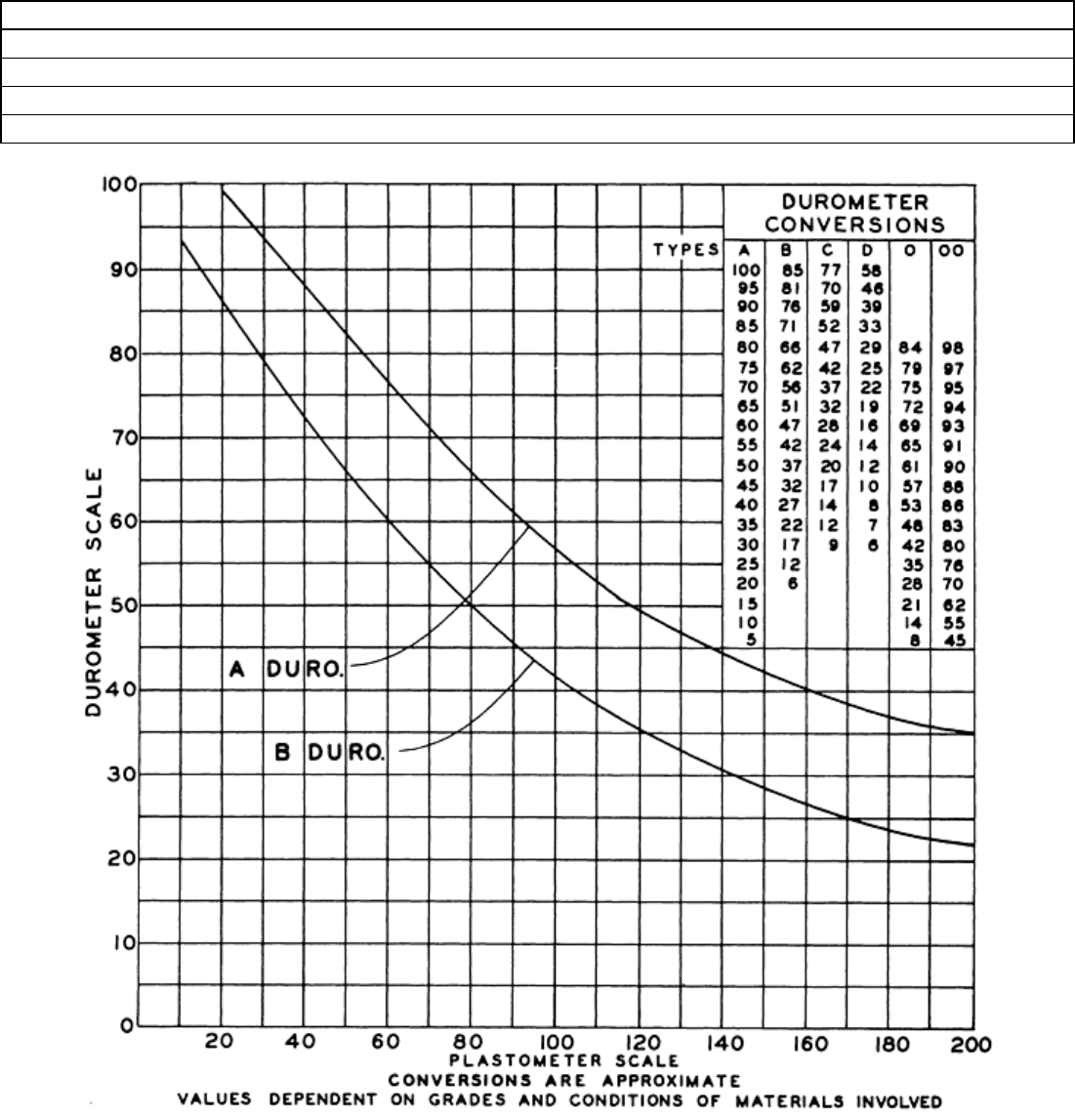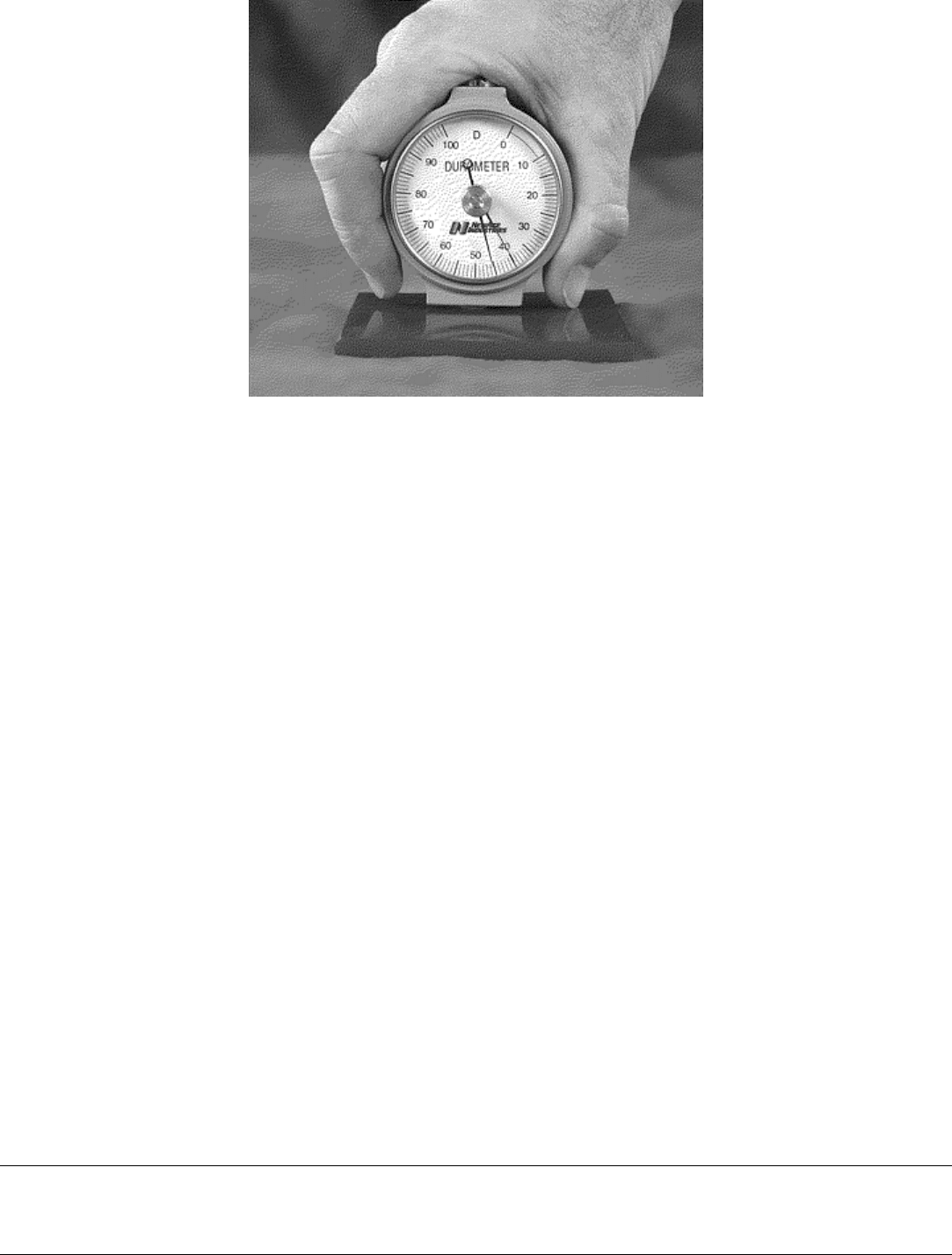ASM Metals HandBook Vol. 8 - Mechanical Testing and Evaluation
Подождите немного. Документ загружается.


Table 12 Approximate equivalent hardness numbers for wrought coppers (>99% Cu, alloys C10200 through C14200)
Vickers
hardness
No.
Knoop
hardness No.
Rockwell superficial hardness No. Rockwell hardness
No.
Rockwell superficial hardness No. Brinell hardness
No.
1
kgf,
HV
100
gf,
HV
1
kgf,
HK
500
gf,
HK
15T scale,
15
kgf, in.
(1.588
mm)
ball,
HR15T
(a)
15T scale,
15
kgf, in.
(1.588
mm)
ball,
HR15T
(b)
30T scale,
30
kgf, in.
(1.588
mm)
ball,
HR30T
(b)
B scale,
100
kgf,
in.
(1.588
mm)
ball,
HRB
(c)
F scale,
60 kgf,
in.
(1.588
mm)
ball,
HRF
(c)
15T scale,
15 kgf,
in.
(1.588
mm)
ball,
HR15T
(c)
30T scale,
30 kgf,
in.
(1.588
mm)
ball,
HR30T
(c)
45T scale,
45 kgf,
in.
(1.588
mm)
ball,
HR45T
(c)
500 kgf,
10
mm
diam
ball,
HBS
(d)
20 kgf,
2 mm
diam
ball,
HBS
(e)
130 127.0 138.7
133.8 … 85.0 … 67.0 99.0 … 69.5 49.0 … 119.0
128 125.2 136.8
132.1 83.0 84.5 … 66.0 98.0 87.0 68.5 48.0 … 117.5
126 123.6 134.9
130.4 … 84.0 … 65.0 97.0 … 67.5 46.5 120.0 115.0
124 121.9 133.0
128.7 82.5 83.5 … 64.0 96.0 86.0 66.5 45.0 117.5 113.0
122 121.1 131.0
127.0 … 83.0 … 62.5 95.5 85.5 66.0 44.0 115.0 111.0
120 118.5 129.0
125.2 82.0 82.5 … 61.0 95.0 … 65.0 42.5 112.0 109.0
118 116.8 127.1
123.5 81.5 … … 59.5 94.0 85.0 64.0 41.0 110.0 107.5
116 115.0 125.1
121.7 … 82.0 … 58.5 93.0 … 63.0 40.0 107.0 105.5
114 113.5 123.2
119.9 81.0 81.5 … 57.0 92.5 84.5 62.0 38.5 105.0 103.5
112 111.8 121.4
118.1 80.5 81.0 … 55.0 91.5 … 61.0 37.0 102.0 102.0
110 109.9 119.5
116.3 80.0 … … 53.5 91.0 84.0 60.0 36.0 99.5 100.0
108 108.3 117.5
114.5 … 80.5 … 52.0 90.5 83.5 59.0 34.5 97.0 98.0
106 106.6 115.6
112.6 79.5 80.0 … 50.0 89.5 … 58.0 33.0 94.5 96.0
104 104.9 113.5
110.1 79.0 79.5 … 48.0 88.5 83.0 57.0 32.0 92.0 94.0
102 103.2 111.5
108.0 78.5 79.0 … 46.5 87.5 82.5 56.0 30.0 89.5 92.0
100 101.5 109.4
106.0 78.0 78.0 … 44.5 87.0 82.0 55.0 28.5 87.0 90.0
98 99.8 107.3
104.0 77.5 77.5 … 42.0 85.5 81.0 53.5 26.5 84.5 88.0
96 98.0 105.3
102.1 77.0 77.0 … 40.0 84.5 80.5 52.0 25.5 82.0 86.5
94 96.4 103.2
100.0 76.5 76.5 … 38.0 83.0 80.0 51.0 23.0 79.5 85.0
92 94.7 101.0
98.0 76.0 75.5 … 35.5 82.0 79.0 49.0 21.0 77.0 83.0
90 93.0 98.9 96.0 75.5 75.0 … 33.0 81.0 78.0 47.5 19.0 74.5 81.0
88 91.2 96.9 94.0 75.0 74.5 … 30.5 79.5 77.0 46.0 16.5 … 79.0
86 89.7 95.5 92.0 74.5 73.5 … 28.0 78.0 76.0 44.0 14.0 … 77.0
84 87.9 92.3 90.0 74.0 73.0 … 25.5 76.5 75.0 43.0 12.0 … 75.0

82 86.1 90.1 87.9 73.5 72.0 … 23.0 74.5 74.5 41.0 9.5 … 73.0
80 84.5 87.9 86.0 72.5 71.0 … 20.0 73.0 73.5 39.5 7.0 … 71.5
78 82.8 85.7 84.0 72.0 70.0 … 17.0 71.0 72.5 37.5 5.0 … 69.5
76 81.0 83.5 81.9 71.5 69.5 … 14.5 69.0 71.5 36.0 2.0 … 67.5
74 79.2 81.1 79.9 71.0 68.5 … 11.5 67.5 70.0 34.0 … … 66.0
72 77.6 78.9 78.7 70.0 67.5 … 8.5 66.0 69.0 32.0 … … 64.0
70 75.8 76.8 76.6 69.5 66.5 … 5.0 64.0 67.5 30.0 … … 62.0
68 74.3 74.1 74.4 69.0 65.5 … 2.0 62.0 66.0 28.0 … … 60.5
66 72.6 71.9 71.9 68.0 64.5 … … 60.0 64.5 25.5 … … 58.5
64 70.9 69.5 70.0 67.5 63.5 … … 58.0 63.5 23.5 … … 57.0
62 69.1 67.0 67.9 66.5 62.0 … … 56.0 61.0 21.0 … … 55.0
60 67.5 64.6 65.9 66.0 61.0 … … 54.0 59.0 18.0 … … 53.0
58 65.8 62.0 63.8 65.0 60.0 … … 51.5 57.0 15.5 … … 51.5
56 64.0 59.8 61.8 64.5 58.5 … … 49.0 55.0 13.0 … … 49.5
54 62.3 57.4 59.5 63.5 57.5 … … 47.0 53.0 10.0 … … 48.0
52 60.7 55.0 57.2 63.0 56.0 … … 44.0 51.5 7.5 … … 46.5
50 58.9 52.8 55.0 62.0 55.0 … … 41.5 49.5 4.5 … … 44.5
48 57.3 50.3 52.7 61.0 53.5 … … 39.0 47.5 1.5 … … 42.0
46 55.8 48.0 50.2 60.5 52.0 … … 36.0 45.0 … … … 41.0
44 53.9 45.9 47.8 59.5 51.0 … … 33.5 43.0 … … … …
42 52.2 43.7 45.2 58.5 49.5 … … 30.5 41.0 … … … …
40 51.3 40.2 42.8 57.5 48.0 … … 28.0 38.5 … … … …
(a) For 0.010 in. (0.25 mm) strip.
(b) For 0.020 in. (0.51 mm) strip.
(c) For 0.040 in. (1.02 mm) strip and greater.
(d) For 0.080 in. (2.03 mm) strip.
(e) For 0.040 in. (1.02 mm) strip.
Source: ASTM E 140 (Ref 6)

Table 13 Approximate equivalent hardness numbers for cartridge brass (70% Cu, 30%
Zn)
Rockwell hardness No. Rockwell superficial hardness No. Vickers
hardness
No., HV
B scale, 100
kgf, in.
(1.588 mm)
ball, HRF
F scale, 60
kgf, in.
(1.588 mm)
ball, HRF
15T scale,
15 kgf,
in.
(1.588 mm)
ball, HR15T
30T scale,
30 kgf,
in.
(1.588 mm)
ball, HR30T
45T scale,
45 kgf,
in.
(1.588 mm)
ball, HR45T
Brinell
hardness No.
500 kgf, 10
mm ball,
HBS
196 93.5 110.0 90.0 77.5 66.0 169
194 … 109.5 … … 65.5 167
192 93.0 … … 77.0 65.0 166
190 92.5 109.0 … 76.5 64.5 164
188 92.0 … 89.5 … 64.0 162
186 91.5 108.5 … 76.0 63.5 161
184 91.0 … … 75.5 63.0 159
182 90.5 108.0 89.0 … 62.5 157
180 90.0 107.5 … 75.0 62.0 156
178 89.0 … … 74.5 61.5 154
176 88.5 107.0 … … 61.0 152
174 88.0 … 88.5 74.0 60.5 150
172 87.5 106.5 … 73.5 60.0 149
170 87.0 … … … 59.5 147
168 86.0 106.0 88.0 73.0 59.0 146
166 85.5 … … 72.5 58.5 144
164 85.0 105.5 … 72.0 58.0 142
162 84.0 105.0 87.5 … 57.5 141
160 83.5 … … 71.5 56.5 139
158 83.0 104.5 … 71.0 56.0 138
156 82.0 104.0 87.0 70.5 55.5 136
154 81.5 103.5 … 70.0 54.5 135
152 80.5 103.0 … … 54.0 133
150 80.0 … 86.5 69.5 53.5 131
148 79.0 102.5 … 69.0 53.0 129
146 78.0 102.0 … 68.5 52.5 128
144 77.5 101.5 86.0 68.0 51.5 126
142 77.0 101.0 … 67.5 51.0 124
140 76.0 100.5 85.5 67.0 50.0 122
138 75.0 100.0 … 66.5 49.0 121
136 74.5 99.5 85.0 66.0 48.0 120
134 73.5 99.0 … 65.5 47.5 118
132 73.0 98.5 84.5 65.0 46.5 116
130 72.0 98.0 84.0 64.5 45.5 114
128 71.0 97.5 … 63.5 45.0 113
126 70.0 97.0 83.5 63.0 44.0 112
124 69.0 96.5 … 62.5 43.0 110
122 68.0 96.0 83.0 62.0 42.0 108
120 67.0 95.5 … 61.0 41.0 106
118 66.0 95.0 82.5 60.5 40.0 105
116 65.0 94.5 82.0 60.0 39.0 103
114 64.0 94.0 81.5 59.5 38.0 101

112 63.0 93.0 81.0 58.5 37.0 99
110 62.0 92.6 80.5 58.0 35.5 97
108 61.0 92.0 … 57.0 34.5 95
106 59.5 91.2 80.0 56.0 33.0 94
104 58.0 90.5 79.5 55.0 32.0 92
102 57.0 89.8 79.0 54.5 30.5 90
100 56.0 89.0 78.5 53.5 29.5 88
98 54.0 88.0 78.0 52.5 28.0 86
96 53.0 87.2 77.5 51.5 26.5 85
94 51.0 86.3 77.0 50.5 24.5 83
92 49.5 85.4 76.5 49.0 23.0 82
90 47.5 84.4 75.5 48.0 21.0 80
88 46.0 83.5 75.0 47.0 19.0 79
86 44.0 82.3 74.5 45.5 17.0 77
84 42.0 81.2 73.5 44.0 14.5 76
82 40.0 80.0 73.0 43.0 12.5 74
80 37.5 78.6 72.0 41.0 10.0 72
78 35.0 77.4 71.5 39.5 7.5 70
76 32.5 76.0 70.5 38.0 4.5 68
74 30.0 74.8 70.0 36.0 1.0 66
72 27.5 73.2 69.0 34.0 … 64
70 24.5 71.8 68.0 32.0 … 63
68 21.5 70.0 67.0 30.0 … 62
66 18.5 68.5 66.0 28.0 … 61
64 15.5 66.8 65.0 25.5 … 59
62 12.5 65.0 63.5 23.0 … 57
60 10.0 62.5 62.5 … … 55
58 … 61.0 61.0 18.0 … 53
56 … 58.8 60.0 15.0 … 52
54 … 56.5 58.5 12.0 … 50
52 … 53.5 57.0 … … 48
50 … 50.5 55.5 … … 47
49 … 49.0 54.5 … … 46
48 … 47.0 53.5 … … 45
47 … 45.0 … … … 44
46 … 43.0 … … … 43
45 … 40.0 … … … 42
Source: ASTM E 140 (Ref 6)
Magnesium and magnesium alloys are tested by applying the Rockwell B scale, but when the alloys are softer
(annealed), the indenter size is increased to 3.175 mm (⅛ in.) using the Rockwell E scale. As with other metals
and alloys, thin sections of magnesium alloys must be tested with the 15T or 30T scale to avoid the anvil effect.
Titanium. The Rockwell A scale is best suited for testing titanium. The 60 kgf load tends to increase the life of
the diamond penetrator because there is an affinity between diamond and titanium, which usually shortens
diamond life. Titanium tends to adhere to the tip of the diamond penetrator and can readily be removed with 3/0
grade emery paper when the penetrator is rotated in a lathe. Maintaining a clean diamond will give more
reliable results.
Zinc and lead alloys are typically tested using the Rockwell method. They exhibit extensive time-dependent
plasticity characteristics and therefore require longer dwell time of load application to obtain accurate and
repeatable results. For materials that show some time-dependent plasticity, the dwell time of indent load should
be 5 to 6 s using a diamond indenter. For materials that show considerable time-dependent plasticity, dwell time
should be 20 to 25 s using any indenter. One method for determining the magnitude of time-dependent
plasticity is to do a series of tests at progressively longer dwell times. As the dwell increases the hardness

values will decrease significantly. When the rate of change decreases significantly the proper dwell time has
been reached.
Zinc. The Rockwell E scale is used for zinc sheets down to 3.2 mm (0.125 in.) and the Rockwell H scale for
sheets down to 1.25 mm (0.050 in.) gage. These values are for zinc in the soft condition, thinner sheets may be
tested if the zinc is relatively hard. For thinner sheet, the 15T or 30T scale of the Rockwell superficial tester
should be used.
Lead. Most testing on lead is done on thicker specimens with the Rockwell E and H scales.
Tin plate is tested on the Rockwell superficial HR15T, HR30T, and HR45T scales along with a diamond spot
anvil in accordance with the following criteria:
Thickness
mm in.
Scale
<0.212 <0.0083 HR15T
0.213–0.547
0.0084–0.0215
HR30T
0.548–0.770
0.0216–0.0303
HR45T
Since most results are reported in the HR30T scales, all test results in the other scales are converted using the
standard conversion chart found in ASTM E 140 (Ref 6).
Cemented carbides are tested primarily with the Rockwell A scale as designated in ASTM B 294 (Ref 7). Using
the Rockwell C scale has resulted in poor diamond longevity due to breakage. Because of the extremely high
stress placed on the diamond point, only indenters designated for carbide testing should be used. It should be
noted that the carbide Rockwell A scale hardness levels are not the same as the steel Rockwell A scale levels
because of the use of diamond indenters. Interchanging indenters will give incorrect results. See the section on
Rockwell hardness testing in the article “Macroindentation Hardness Testing” for more information about the
differences.
Cemented carbides are P/M products produced by sintering and thus may also contain tiny voids. However, the
amount of void area on the surface usually is not large enough to complicate hardness testing. Cemented
carbides are also composite materials made of hard carbides with a cobalt binder. The soft cobalt binder
occupies approximately 20% of the area, whereas the remaining 80% consists of hard carbide particles that
have hardness values of 9 on Mohs scale (diamond is 10) or 1500 HV and above. Obviously, the
macroindentation hardness is an average value for this composite material. The carbide content is the principal
contributor to the hardness.
Hardness Testing of Plastics
Hardness testing of plastics presents many variables that do not relate to the testing of metals. For example,
plastics are much more sensitive to humidity and temperature than metals. The deformation of plastics is also
very time dependent, and plastics may exhibit excessive flow characteristics during force applications. Because
of these extenuating factors special procedures are given in ASTM D 785 (Ref 2) for Rockwell testing of
plastics. These include:
5. Conditioning of the test specimen at a controlled temperature and relative humidity level
6. Requirements for the application and dwell time of the preliminary force
7. Application of the additional force within 10 s of applying the preliminary force
8. Removing the additional force, after the extended dwell time (usually 15 s) or until further penetration
has apparently stopped, as indicated with the depth indicator (gage)
9. Extending the read time to 15 s after the removal of the additional force
It should be noted that some of these same conditions also apply to Vickers or Knoop hardness testing of
plastics.
In the Rockwell test (ASTM D 785) (Ref 2), penetrators generally are balls 3.18, 6.35, and 12.7 mm (0.125,
0.25, and 0.50 in.) diameter at major loads of 60, 100, and 150 kg. Because of the creep and recovery
characteristics of plastics, dwell times are carefully controlled, and specimens should be conditioned for
temperature and humidity. Hardness tests on plastics are an indication of cure of some thermosetting materials
and an indication of punching quality of laminated sheet stock.
For metals, excluding shapes such as tubes, the movement of the dial gage caused by the elasticity of the metal
being tested is small and not considered to be a problem. Elasticity may reach considerable proportions with
plastics. In addition to the spring of the tester frame, elasticity may prevent full application of the major load
because of limitations in the design of the tester.
The limitation of the standard model Rockwell tester is considered to be 150 dial gage divisions under a 150
kgf load. This figure represents the number of divisions of travel on the dial gage, when the major load is
applied, due to penetration into the material under tests, spring of the frame, penetrator, plunger rod system, and
elasticity of the material under test. Special Rockwell testers, designated as “PL” models, increase this
limitation to 250 divisions under a load of 150 kgf.
To determine whether the machine limitation is being exceeded and the major load is being fully applied, the
major load can be tested in the following manner. With the major load still applied, an additional load can be
applied by manually exerting pressure on the weights on the machine; the dial gage needle then should indicate
additional penetration. If not, the full major load might not be acting (due to reaching limit of depth of
indentation), and faulty readings can result. In this instance, the manufacturer should be contacted.
Use of the Alpha Scale. A variation of the standard Rockwell test is often used for testing plastics. It is referred
to as the alpha Rockwell hardness number in Procedure B of ASTM D 785 (Ref 2). The advantage of the alpha
scale is that it covers the range of plastics.
The standard Rockwell tester is used with a major load of 60 kgf and 12.7 mm (½ in.) ball penetrator. The test
is made by applying the minor load in the usual manner, setting the dial to “set,” and applying the 60 kgf major
load for 15 s. With the major load applied, the number of divisions the penetrator has traveled from “set” is read
on the dial gage. From this reading, the spring of the tester is subtracted, determined under the major load of 60
kgf, and the remainder is subtracted from 150.
The spring of the machine, known as the “spring constant,” is determined as follows:
• Place a soft copper block of sufficient thickness and with plane parallel surfaces on the anvil in the
normal testing position.
• Raise the sample and the anvil by the capstan screw until the large pointer is at the set position.
• Apply the major load by tripping the load release lever.
The dial gage then will indicate the vertical distance of indentation, the spring of the machine frame, and any
other elastic compressible deformation of the plunger rod system and penetrator. This operation should be
repeated several times without moving the block. However, the dial must be reset after each test while under
minor load until the deflection of the dial gage becomes constant—that is, until no further indentation takes
place, and only the spring of the instrument remains. This value, in terms of dial divisions, is the spring
constant.
Durometer Testing. The durometer is a well-known and widely used instrument for measuring hardness of
virtually all types of plastics, rubbers, and various rubberlike materials. The durometer measures hardness by
means of an indentation much like that used in hardness testing of metals. The indenters used in durometers,
however, are spring loaded rather than forced by weights. Nonmetallic materials, similar to metals, vary greatly
in hardness, thus requiring a variety of test instruments. Several types of durometers accommodate the full
range of hardness, and special instruments are available for testing O-rings and extremely thin materials. The
various types available are listed in the left column of Table 14; however, only two (A and D) are covered in
ASTM D 2240 (Ref 8).

Table 14 Specifications of durometers
Durometer
type
Main
spring
Indenter Applications
A (conforms
ASTM D 2240)
822 g Frustum
cone
Soft vulcanized rubber and all elastomeric materials, natural
rubber, GR-S, GR-1, neoprene, nitrile rubbers, Thiokol, flexible
polyester cast resins, polyacrylic esters, wax, felt, and leather
B 822 g Sharp 30°
included
angle
Moderately hard rubber such as typewriter rollers and platens
C 20 lb Frustum
cone
Medium-hard rubber and plastics
D (conforms to
ASTM D 2240)
10 lb Sharp 30°
included
angle
Hard rubber and the harder grades of plastics such as rigid
thermoplastic sheet. Plexiglas (AtoHaas Americas Inc.),
polystyrene, vinyl sheet, cellulose acetate and thermosetting
laminates such as Formica (Formica Corp., Cincinnati, OH), paper-
filled calendar rolls, and calendar bowls
D0 10 lb
2.4 mm (
in.) sphere
Very dense textile windings and slasher beams
0 822 g
2.4 mm (
in.) sphere
Soft printer rollers, Artgum, medium-density textile windings of
rayon, orlon, and nylon
00 4 oz
2.4 mm (
in.) sphere
Sponge rubber and plastics, low-density textile windings; not for
use on foamed latex
000 (available
with round dial
only)
4 oz
13 mm (
in.) diam
spherical
Ultrasoft sponge rubber and plastic
T 822 g
2.4 mm (
in.) sphere
Medium-density textile windings on spools and bobbins with a
maximum diam of 100 mm (4 in.); types T and T-2 have a concave
bottom plate to facilitate centering on cylindrical specimens
Durometers are used for measuring hardness of plastics and rubbers ranging from ultrasoft sponge rubbers to
hard plastics. A list of test materials correlated with the specific type of durometer, main spring data, and type
of indenter is presented in Table 15. In some instances, durometer test results can be converted to another scale.
A partial conversion chart is shown in Fig. 8. The types of durometers range from simple handheld devices
(Fig. 9) to laboratory instruments with digital readout for accurate and reproducible readings. Materials that are
too thin for hardness measurement by conventional instruments can be measured with durometers for thin and
microthin samples.
Table 15 Taylor's equations for estimating the tensile strength from hardness data
Material Tensile strength (MPa) Tensile strength (ksi)
Heat treated carbon and alloy steels (3.24–3.55) HB (0.470–0.515) HB
Annealed carbon steels (3.55–3.86) HB (0.515–0.560) HB
All steels (3.09–3.55) HB (0.448–0.515) HV
Nickel-chromium austenitic stainless steels (3.09–3.32) HV (0.448–0.482) HV
Steel: sheet, strip, and tube (2.85–3.71) HV (0.414–0.538) HV
Aluminum alloys: bar and extrusions (2.94–4.48) HB
(2.85–4.17) HV
(0.426–0.650) HB
(0.414–0.605) HV
Aluminum alloys: sheet, strip, and tube (3.24–4.01) HV (0.470–0.582) HV

Aluminum-copper castings (1.70–2.94) HB (0.246–0.426) HB
Al-Si-Ni castings (2.32–2.94) HB (0.336–0.426) HB
Aluminum-silicon castings (2.63–3.71) HB (0.381–0.538) HB
Phosphor bronze castings (2.32–3.24) HB (0.336–0.470) HB
Brass castings (3.24–4.63) HB (0.470–0.672) HB
Source: Ref 9
Fig. 8 Durometer-plastometer conversion chart. Courtesy of Shore Instruments, Division
of Instron Corporation

Fig. 9 Handheld durometer for testing hardness of plastic and rubber materials. Courtesy
of NewAge Industries
Additional information about durometer testing is provided in the article “Miscellaneous Hardness Tests” in
this Volume.
References cited in this section
1. “Standard Test Method for Rockwell Hardness of Plastics and Electrical Insulating Materials,” D 785-
98, Annual Book of ASTM Standards, ASTM
2. “Determination of Apparent Hardness of Powder Metallurgy Products,” MPIF 43 (1995), Standard Test
Methods for Metal Powders and Powder Metallurgy Products, Metal Powder Industries Federation,
1999
4. “Determination of Microhardness of Powder Metallurgy Materials,” MPIF 51 (1994), Standard Test
Methods for Metal Powders and Powder Metallurgy Products, Metal Powder Industries Federal, 1999
5. “Standard Hardness Conversion Tables for Metals (Relationship among Brinell Hardness, Vickers
Hardness, Rockwell Hardness, Rockwell Superficial Hardness, Knoop Hardness, and Scleroscope
Hardness),” E 140-97e1, Annual Book of ASTM Standards, ASTM
6. “Standard Test Method for Hardness Testing of Cemented Carbides,” B 294-92(1997), Annual Book of
ASTM Standards, ASTM
7. “Standard Test Method for Rubber Property-Durometer Hardness,” D 2240-97e1, Annual Book of
ASTM Standards, ASTM
8. W.J. Taylor, The Hardness Test as a Means of Estimating the Tensile Strength of Metals, J. Royal
Aeronaut. Soc., Vol 46 (No. 380), 1942, p 198–209
Selection and Industrial Applications of Hardness Tests
Andrew Fee, Consultant
Applications of Hardness Testing
Hardness testing has many applications in quality control, materials evaluation, and the prediction of properties.
Because hardness testing is nondestructive and quick, it is a very useful tool for manufacturing and process
control. For example, the most common application of the Rockwell test is testing steels that have been
hardened and tempered. If a hardened-and-quenched steel piece is tempered by reheating at a controlled and
relatively low temperature and then cooled at a control rate and time, it is possible to produce a wide range of
desired hardness levels. By using a hardness test to monitor the end results, the operator is able to determine
and control the ideal temperatures and times so that a specified hardness may be obtained.
Quality Control
Decarburization. In general, decarburization is an unwanted condition that results in a softer surface (or skin) on
the metal. This is caused by the loss of carbon from the surface of the material during a heat treatment process.
Unless it is removed, the part may not have the properties necessary to perform its function. A Rockwell test,
because it is done on the surface of the part, will frequently indicate this soft condition. An example of the most
commonly used method to determine if decarburization exists is to make Rockwell 15N and C scale tests in the
same area of the part. When the converted values are compared, if the Rockwell 15N value, converted to C, is
significantly lower than the unconverted Rockwell C value, a soft, decarburized layer is most likely present.
Removing the layer and retesting will confirm the diagnosis.
Statistical Process Control (SPC). When large populations of materials make testing each workpiece impractical
and a tighter control is demanded for a product, SPC is usually incorporated. This means of statistical control
can enable continual product manufacturing with minimum testing and a high level of quality. Because many
hardness tests are done rapidly, they are well suited for use with SPC techniques. Users are cautioned that the
proper testing procedures must be followed to ensure the high degree of accuracy necessary when using SPC.
Measurement of Case Depth
The surface layer of case-hardened steels is generally characterized in terms of:
• Case hardness
• Effective case depth (typically defined as the depth where hardness has a value of 50 HRC, unless
otherwise specified)
• Total case depth (which is the depth at which no difference in chemical or physical properties can be
distinguished between the case and the core)
In testing case-hardened material it is essential that the depth of case be sufficient to support the test being
conducted. The rule that the case be at least 10 times thicker than the depth of indentation should be followed.
This 10-to-1 ratio is based on the flow characteristics of most steels; if, however, the material being tested has
flow characteristics unlike most steels a greater ratio may be required.
The most accurate and repeatable method of determining effective or total case depth is by means of some type
of hardness traverse. A hardness traverse indicates the precise hardness characteristics from the edge to the
core. Hardness depths may be studied by either taper or step grinding as illustrated in Fig. 10. When the case is
very thin, but quite hard, as usually found in materials that have been nitrided, a more qualitative method for
determining case depth is done by making a microindentation hardness traverse on a cross section of a prepared
specimen. Surface hardness can be determined on cases as thin as 10 μm (0.0005 in.) with this method. The
cross-section method, while time consuming, is the most common process used to determine case depth.
